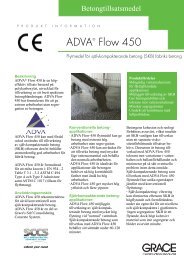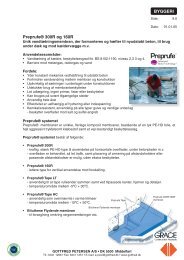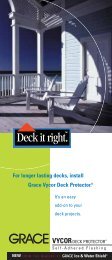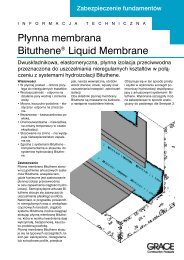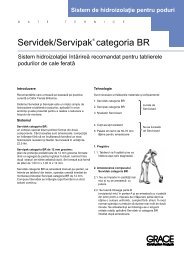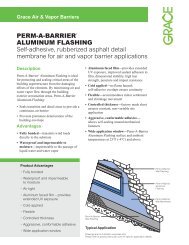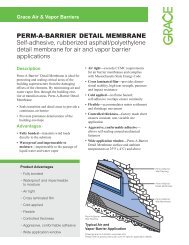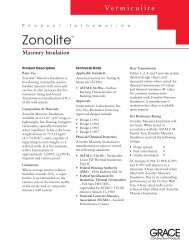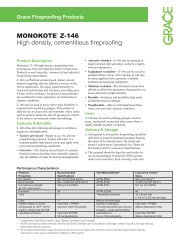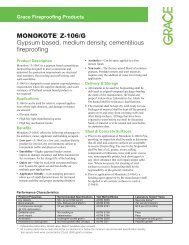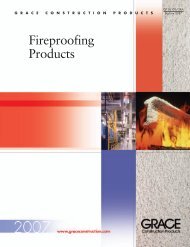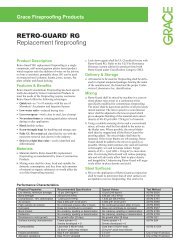Eclipse® Shrinkage Reducing Admixture - Grace Construction ...
Eclipse® Shrinkage Reducing Admixture - Grace Construction ...
Eclipse® Shrinkage Reducing Admixture - Grace Construction ...
You also want an ePaper? Increase the reach of your titles
YUMPU automatically turns print PDFs into web optimized ePapers that Google loves.
T E C H N I C A L B U L L E T I N T B - 1 0 0 0<br />
Concrete<br />
Eclipse ® <strong>Shrinkage</strong> <strong>Reducing</strong> <strong>Admixture</strong><br />
Eclipse ® <strong>Shrinkage</strong> reducing admixture is a liquid concrete admixture which reduces<br />
material shrinkage due to drying. This technical bulletin outlines recommended shrinkage<br />
testing mix matrixes, reviews pertinent sections of ASTM C157, “Standard Test Method for<br />
Length Change of Hardened Hydraulic-Cement Mortar and Concrete,” and details a<br />
suggested format for reporting laboratory shrinkage test results.<br />
<strong>Shrinkage</strong> Testing Mix Matrix<br />
• Water content, mortar paste fraction, admixture selection, cementitious and pozzolan types<br />
and quantities, coupled with aggregate characteristics and mix design proportions most<br />
significantly impact concrete’s drying shrinkage characteristics. Careful selection of these<br />
variables are critical when designing and testing low shrinkage mixes.<br />
• Drying shrinkage properties of Eclipse admixed concrete is typically, but not always, linear<br />
from 1% to 2.5% by weight of cement Eclipse dosage rates. Therefore, it is recommended<br />
concrete admixed with, at a minimum, low and high dosage rates of Eclipse be included in<br />
the shrinkage test matrix.<br />
• Reference concrete containing no Eclipse must be included in the test matrix. This is<br />
essential because Eclipse admixed concrete shrinkage performance is measured relative to<br />
reference concrete shrinkage performance.<br />
• It is recommended both superplasticized and mid-range water reduced mixes be<br />
incorporated into the shrinkage test matrix, since these admixtures may optimize<br />
reductions in drying shrinkage.<br />
ASTM C157 <strong>Shrinkage</strong> Test Procedure (including Recommended<br />
Modifications)<br />
ASTM C157, “Standard Test Method for Length Change of Hardened Hydraulic-Cement<br />
Mortar and Concrete” is the most common and applicable procedure for determining length<br />
change of hardened hydraulic-cement concrete. This test procedure is rather detailed,<br />
therefore it is advisable that local laboratories clearly demonstrate shrinkage testing<br />
proficiency prior to the initiation of an Eclipse shrinkage test program. Several specific<br />
ASTM C157 equipment requirements are depicted below (refer to applicable ASTM standard<br />
for further detail):<br />
• 76 mm x 76 mm x 286 mm (3 in. x 3 in. x 11.25 in.) steel molds with 254 mm (10 in.)<br />
nominal gage lengths if all aggregate passes a 25 mm (1 in.) sieve. If the aggregate passes<br />
a 51 mm (2 in.) sieve, 102 mm x 102 mm x 286 mm (4 in. x 4 in. x 11.25 in.) steel molds<br />
are used (refer to ASTM C490 and ASTM C157)
• Length comparator and reference bar (refer to ASTM C490)<br />
• Drying room with the capacity to maintain temperatures of 23.0 ± 1.7°C (73.4 ± 3°F) and<br />
relative humidity of 50 ± 4%. Horizontal drying room racks must allow for non restricted<br />
air circulation around shrinkage specimens (refer to ASTM C157)<br />
• Storage tank for lime saturated water curing (refer to ASTM C511)<br />
Concrete Sampling<br />
Lab concrete shall be sampled in accordance with ASTM C192, while field concrete shall be<br />
sampled in accordance with ASTM C172. Plastic concrete tests including slump, air, unit<br />
weight and temperature shall be conducted and recorded for each concrete sample.<br />
Compressive strength testing shall be conducted at a minimum of 2 ages (including 28 days)<br />
and set time testing is also recommended.<br />
<strong>Shrinkage</strong> Specimen Fabrication<br />
Concrete shall be placed in shrinkage molds in two approximately equal layers and<br />
consolidated by rodding, unless the slump is less than 76 mm (3 in.), at which time vibration<br />
shall be used. The concrete shall be carefully hand worked around each gage stud, followed<br />
by striking off with a straight edge. The steel plates holding the gage studs at the end of each<br />
mold should be loosened after consolidation.<br />
Curing from 0 Hours to 23 ± 1 ⁄2 Hours<br />
ASTM C157 requires moist cabinet or moist room curing per ASTM C511 during the initial<br />
period. However, if the specimen top surfaces are covered with plastic or wet burlap, it<br />
should be acceptable to cure specimens in ambient conditions, since all of the specimen<br />
surface area will be covered, thereby not allowing moisture to migrate out. ASTM C157 test<br />
deviations should be noted in report.<br />
Initial <strong>Shrinkage</strong> Reading<br />
At time 23 ± 1 ⁄2 hour, specimens are carefully demolded and placed in lime saturated water<br />
maintained at 23.0 ± 1.7°C (73.4 ± 3°F) for minimum 30 minutes. At time 24 ± 1 ⁄2 hour,<br />
initial comparator readings (called 1 day reading) are taken on wiped down specimens, which<br />
are then placed back in the lime saturated water tank.<br />
Lime Saturated Water Curing – 1 day up to maximum 28 days<br />
ASTM C157 states “After the initial comparator reading, store the specimens in lime<br />
saturated water at 23.0 ± 1.7°C (73.4 ± 3°F) until they have reached an age of 28 days,<br />
including the period in the molds, unless another condition or duration of curing is<br />
specified”. THIS STATEMENT IMPLIES 28 DAY WET CURING IS NOT REQUIRED BY<br />
ASTM. <strong>Grace</strong> recommends an additional 6 days of lime saturated water curing, which brings<br />
the specimen age to 7 days.<br />
Note: ASTM C494, “Standard Specification for Chemical <strong>Admixture</strong>s for Concrete,” Section<br />
17.1.4 Length Change states “Test specimens shall be tested in accordance with Test Method<br />
C157 except that the moist curing period, including the period in the molds, shall be<br />
14 days”. This statement reaffirms that a 28 day moist cure is not absolutely required.
Air Curing/<strong>Shrinkage</strong> Readings<br />
At 7 days, a second comparator reading is taken (called 7 day reading) and the specimens are<br />
placed on the drying room racks. This is the start of air curing, which should continue to<br />
minimum 56 days, but ideally to 365 days. Subsequent shrinkage readings are taken at an<br />
array of ages, often including, but not limited to 14, 21, 28, 35, 56, 90, 180 and 365 days.<br />
Length Change Calculations<br />
The pertinent value calculated from shrinkage test results is ∆L. ∆L is the length change in<br />
percent (%) of a specimen relative to the specimens initial (1 day) reading.<br />
Length change (%) is calculated via ∆L CRD (1 day) CRD 100<br />
∆L = length change of specimen at a particular age, %<br />
CRD = difference between the comparator reading of the specimen and the<br />
reference bar at any age<br />
G = gage length, 254 mm (10 in.)<br />
In this bulletin, negative ∆L values represent beam expansion, which is likely to occur during<br />
wet curing, with positive ∆L values representing beam shrinkage occurring during air curing.<br />
Suggested Format for Reporting ASTM C157 Test Results<br />
Average CRD and ∆L values for 3 shrinkage specimens is depicted in the table below.<br />
∆L is easily calculated using the length change equation shown above and CRD data.<br />
ASTM C157 Data – Difference in Specimen Length versus Reference Bar (CRD)<br />
and Total Length Change versus 1 Day (∆L-measured in %)<br />
Reference Low Eclipse High Eclipse<br />
CRD ∆L CRD ∆L CRD ∆L<br />
(avg. 3 bars) (%) (avg. 3 bars) (%) (avg. 3 bars) (%)<br />
1 day 0.1735 — 0.1808 — 0.1843 —<br />
7 day 0.1741 -0.006 0.1813 -0.005 0.1850 -0.007<br />
14 day 0.1723 0.012 0.1801 0.007 0.1845 -0.002<br />
21 day 0.1710 0.025 0.1792 0.016 0.1834 0.009<br />
28 day 0.1701 0.034 0.1788 0.020 0.1830 0.013<br />
35 day 0.1696 0.039 0.1784 0.024 0.1827 0.016<br />
56 day 0.1691 0.044 0.1778 0.030 0.1823 0.020<br />
90 day 0.1688 0.047 0.1777 0.031 0.1822 0.021<br />
365 day 0.1685 0.050 0.1776 0.032 0.1821 0.022<br />
G
The next step is to graphically plot ∆L or Length Change (%) on the Y axis versus Time<br />
(days) on the X axis. 365 day data is not depicted because it unnecessarily extends the length<br />
of the X axis, thereby compressing critical 0-90 day shrinkage data.<br />
Length Change (%)<br />
0.0500<br />
0.0400<br />
0.0300<br />
0.0200<br />
0.0100<br />
0.0000<br />
Length Change (%) versus Time<br />
-0.0100<br />
0 10 20 30 40 50 60 70 80 90<br />
Time (days)<br />
Finally, Eclipse concrete shrinkage data expressed as percent reduction compared to<br />
reference concrete is shown at right at 28, 90 and 365 days. This is the pertinent information<br />
engineers and specifiers will be requiring for confirmation of Eclipse shrinkage performance.<br />
Eclipse Concrete versus Reference Concrete <strong>Shrinkage</strong> Performance<br />
(expressed as % <strong>Shrinkage</strong> Reduction of Reference)<br />
28 Day 90 Day 365 Day<br />
Low dosage Eclipse 41 34 36<br />
High dosage Eclipse 62 55 56<br />
North American Customer Service: 877-4AD-MIX1 (877-423-6491)<br />
Visit our web site at www.graceconstruction.com<br />
Reference<br />
Low Eclipse<br />
High Eclipse<br />
W. R. <strong>Grace</strong> & Co.-Conn. 62 Whittemore Avenue Cambridge, MA 02140 617-876-1400<br />
Eclipse is a registered trademark of W. R. <strong>Grace</strong> & Co.-Conn.<br />
We hope the information here will be helpful. It is based on data and knowledge considered to be true and accurate and is offered for the users’ consideration, investigation<br />
and verification, but we do not warrant the results to be obtained. Please read all statements, recommendations or suggestions in conjunction with our conditions of<br />
sale, which apply to all goods supplied by us. No statement, recommendation or suggestion is intended for any use which would infringe any patent or copyright.<br />
W. R. <strong>Grace</strong> & Co.-Conn., 62 Whittemore Avenue, Cambridge, MA 02140. In Canada, <strong>Grace</strong> Canada, Inc., 294 Clements Road, West, Ajax, Ontario, Canada L1S 3C6.<br />
These products may be covered by patents or patents pending. Copyright 2006. W. R. <strong>Grace</strong> & Co.-Conn. TB-1000A Printed in USA 2/06 FA/PDF



